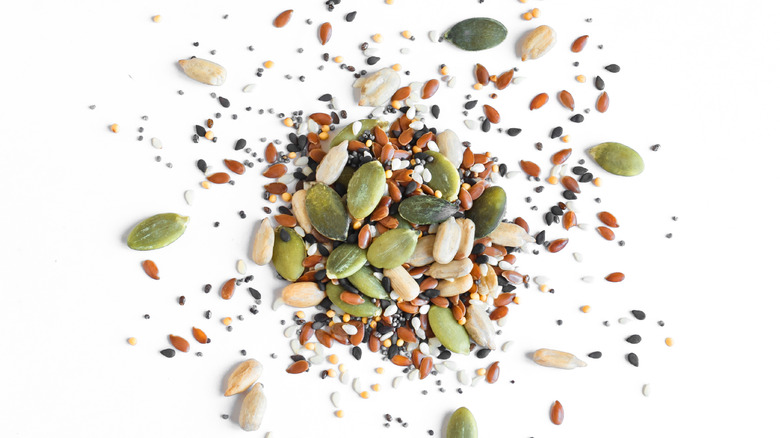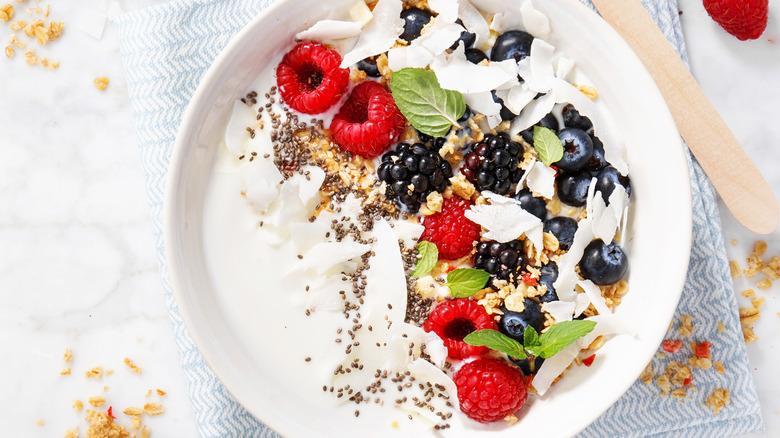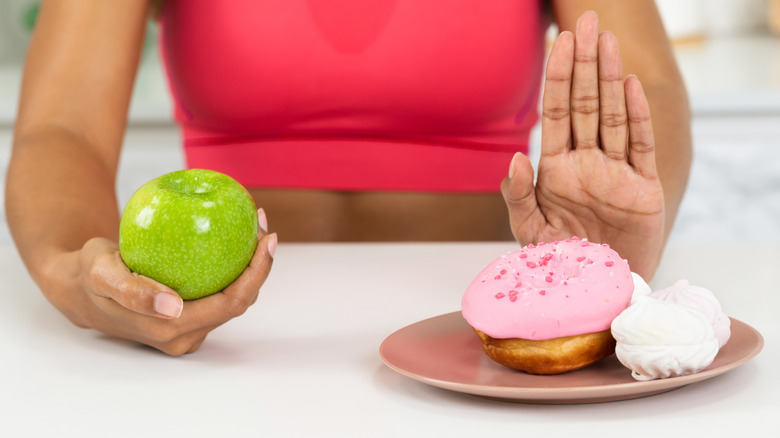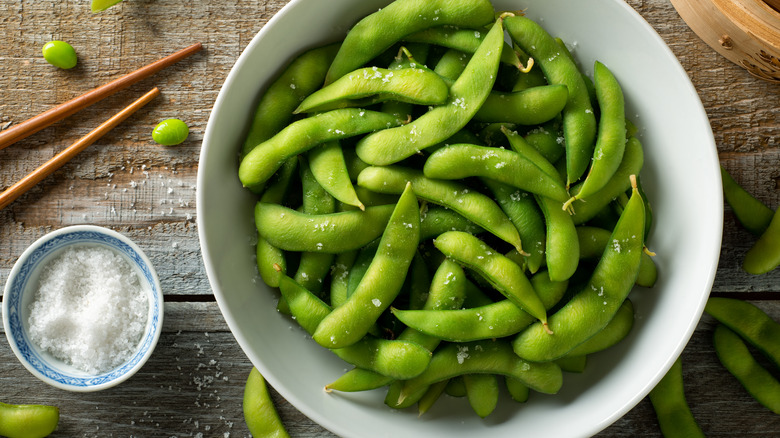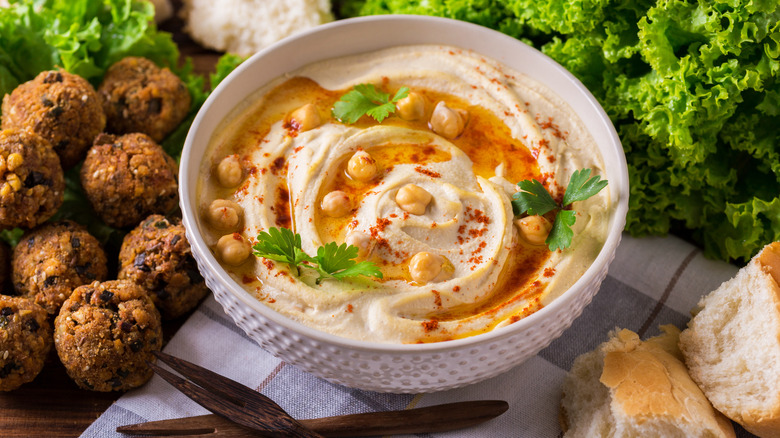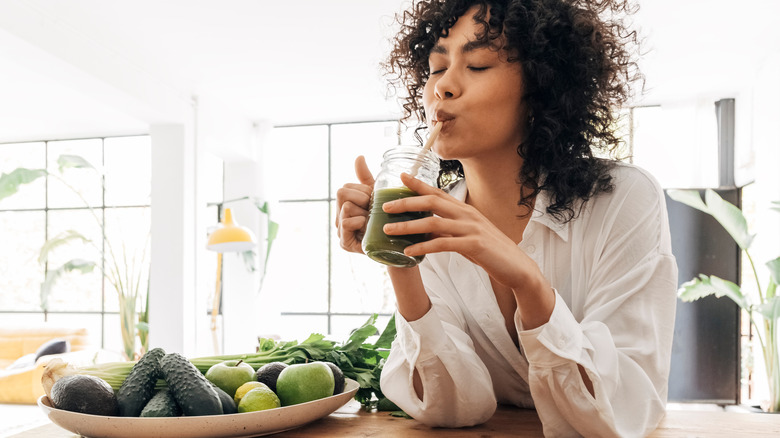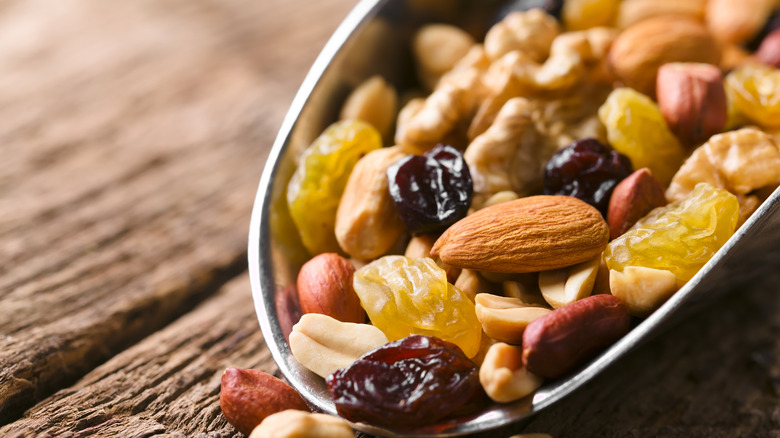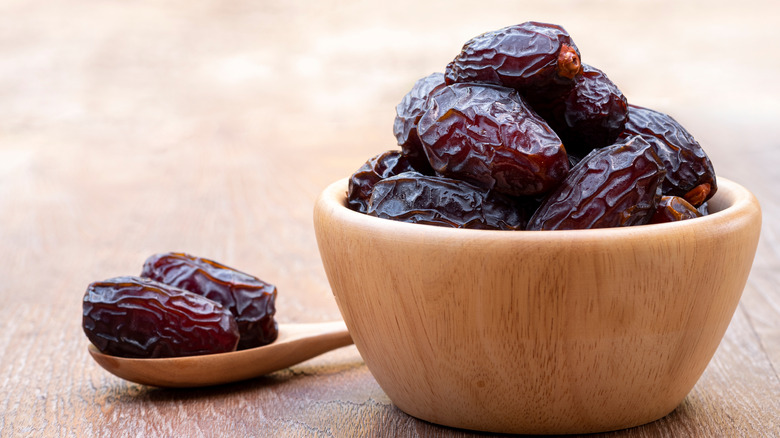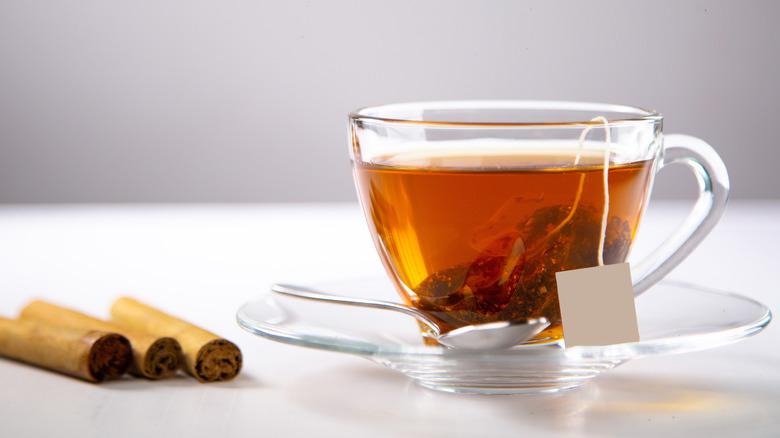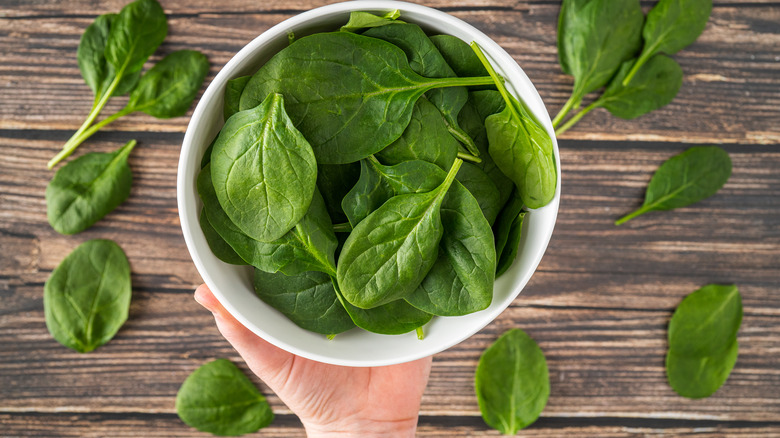Eat These Foods Instead If You're Craving Sugar
Ah, sugar. Sugary foods hit the spot when our brains seem to crave them. However, our bodies want just about anything but sugar. According to Harvard Health Publishing, eating a diet with too much sugar is one of the most significant contributors to heart disease. Harvard nutrition professor Dr. Frank Hu explains that added sugar can increase the risk of heart disease because it leads to more inflammation, higher blood pressure, weight gain, and other conditions that are bad news for our pumpers.
How much sugar is too much? The American Heart Association says that men should eat 36 or fewer grams of added sugar daily, while women should eat no more than 25 grams. Unfortunately, added sugar is in many food items Americans tend to eat regularly, including ketchup, protein bars, and spaghetti sauce (per Healthline).
Another whammy: When you feel like you're craving sugar, you might actually need something else, like water or magnesium. Try swapping the sugar for some of these better-for-you options.
Reach for magnesium-rich pumpkin or chia seeds
One of the costliest mistakes you can make for your body is to feed into its supposed sugar cravings when you actually need a different nutrient. Sometimes, your brain can't distinguish between craving sugar and needing something else, like magnesium. According to holistic nutritionist Elissa Goodman, "If you're craving chocolate, it could mean your body is deficient in magnesium, which is a really common deficiency these days" (via Byrdie).
Magnesium is essential for protein synthesis and blood pressure regulation. It can also keep your blood glucose levels in check, which is an important part of controlling cravings through the day. Most adults need between 310 and 420 milligrams of magnesium daily. Just one ounce of pumpkin seeds provides 156 milligrams, while the same serving of chia seeds offers 111 milligrams, making them some of the best foods to eat if you need more magnesium (via the National Institutes of Health). You might just find that your sugary craving subsides after snacking on these yummy seeds, and your body gets what it really needs.
Replace refined carbs with avocado
Food cravings in general are largely linked to consuming refined carbohydrates like white bread, rice, or cookies from your favorite bakery. That's because our bodies can break down these processed foods fast, and their refined carbs turn into blood glucose. According to researcher David Ludwig via LiveScience, the quick spikes can leave us feeling hungry for more not long after we eat them.
Instead of serving yourself another helping of mashed potatoes or a slice of bread, snack on some avocado. Avocado is low in carbohydrates, and most of its carbs come from fiber, which can keep your digestive tract happy (per Medical News Today). A 2019 study published in Nutrients noted a link between insulin levels and the types of carbs the participants ate, with significantly lower insulin resulting from meals including avocado. The study also found that participants who replaced carbohydrates in their meals with avocado felt fuller and more satisfied after eating. Perhaps, eating some avocado each day could keep the sugar cravings away.
Greek yogurt can be a sweet, healthier treat
Sometimes, a sugar craving may simply be a sweet craving. Once you taste something sweet — even if it has little to no added sugar — it could be enough to make your craving go away. Greek yogurt is an excellent snack when this is the case. It offers a high amount of protein, and most varieties are not loaded with sugar like other yogurts are because it's strained to remove stuff like sugar and lactose (per U.S. News & World Report). Despite its low sugar content, it's relatively sweet, and its thick texture can almost trick your brain into thinking you're snacking on a delectable dessert.
A scientific review published in Nutrition Reviews also explained that yogurt can provide some appetite control, which could help you suppress those sugar cravings throughout the day. Additionally, when compared with chocolate bars, eating yogurt proved to be more helpful in controlling the desire to eat and feeling fuller after eating. Another study included in the review found that, as an afternoon snack, Greek yogurt with high protein content allowed women to delay eating their next meal or snack. For added natural sweetness, add fresh berries to your Greek yogurt.
Opt for the natural sugar in fruit
Fruit has natural sugars that can satisfy your sweet tooth in a healthier way than sweets with added sugars can. In fact, a 2021 study published in the Journal of Clinical Endocrinology & Metabolism found that eating a moderate intake of fruit was associated with a lower risk of developing diabetes within five years. Fruit intake also increased insulin sensitivity and decreased serum insulin in the blood, suggesting a positive effect on the way your body responds to insulin after eating fruit. It's important to note that the study explicitly mentions that fruit, not fruit juice, leads to this response.
Fortunately, there are many fruits to choose from to stave off those sugar cravings. However, it's a good idea to reach for ones that are naturally low in sugar, as they could be even more pivotal in controlling your sweet tooth. Healthline lists lemons, limes, raspberries, strawberries, and blackberries as some of the lowest sugar fruits. Grapefruit, avocado, and watermelon also top the list.
Eat some edamame
It may seem like an odd choice of food to eat when you want something sweet, but edamame has appetite-controlling properties that could get rid of your current sugar craving. Edamame is a whole, immature soybean, usually still in its pod form. One of its standout benefits is its high protein content, making it an excellent protein source for plant-based or vegan dieters. Just one cup yields about 18 grams of protein, according to the USDA FoodData Central.
A 2015 author manuscript published in Obesity explains the importance of a high-protein diet in controlling hunger and cravings. The study's researchers split participants into high-protein and low-protein diets, while also restricting their calories. The high-protein dieters were less likely than the other group to crave late-night snacks, and they generally felt fuller throughout the day.
In addition to its protein content, edamame is low on the glycemic index (per Healthline), so it won't raise blood sugar like a cookie or piece of cake would.
Chew sugar-free gum
Research has shown that chewing gum can fight cravings, possibly even to the point of losing weight. According to WebMD, contestants on the hit reality TV show "The Biggest Loser" sometimes chewed gum when they started feeling hungry, and research found that people who chewed gum consumed fewer calories at mealtime. However, sugar-free gum is the way to go, because it's lower in calories than regular pieces.
One study published in a 2017 edition of Appetite found that people who chewed sugar-free gum for one hour along with eating a controlled-calorie breakfast rated their hunger lower and consumed less for lunch than on days they didn't chew gum.
However, UFHealth warns that eating too much sugar-free gum could have negative consequences, such as diarrhea and unintended weight loss. An artificial sweetener called sorbitol, which is in many sugar-free varieties, could be to blame. If you start noticing tummy troubles after eating a few pieces of sugar-free gum, try scaling back your chewing habit to find your limit.
Hummus can take the place of sweet dressings
Many salad dressings have way more sugar than you probably would have thought. For instance, two tablespoons of Kraft's Signature Oriental Sesame Salad Dressing includes 6 grams of sugar. Meanwhile, a 42-gram single-serve packet of Heinz French Dressing packs in 10 grams of sugar (via Kraft Heinz Foodservice). Getting that much sugar every time you have a salad probably doesn't help keep your sweet tooth in check.
Next time you really want to eat healthy by grabbing a salad, try topping it with hummus instead of dressing. Hummus is high in protein and rich in fiber, so it can potentially assist in controlling your hunger and blood sugar levels. However, Medical News Today warns that some hummus varieties have lots of sodium and added sugar, which is exactly what you want to avoid. Take a few minutes to compare nutrition labels when shopping to buy hummus that's low in these areas and contains unsaturated fats.
Shake up a smoothie
Mix up a smoothie using your favorite fruits, and you could immediately find relief for your sugar craving. Fruit contains natural sugars, so you should still be mindful of how much you're eating (or drinking). But when you combine real, unprocessed fruit with other superfood ingredients that keep you feeling full and give your body must-have nutrients, you'll have a healthy meal that's way better for you than a calorie- and sugar-packed candy bar.
For example, chia seeds can add fiber to your smoothie, making you feel fuller after drinking it. Likewise, flaxseeds blended into a smoothie add omega-3 fatty acids. You can even incorporate some greens to make sure you're getting your daily vegetable servings (per Healthline).
There are also ways to make your smoothie less sweet to help you wean yourself away from sugar cravings. Vitamix suggests using citrus fruits in your smoothie to help balance other sweeter fruits or adding a splash of lemon or lime juice for extra acidity instead of sweetness. Or, if you need a little added sweetness, use a small amount of sweetener rather than sugar, or add some watermelon for natural sweetness.
Find a good-for-you trail mix
Trail mix comes in all kinds of varieties, from salty to sweet to blends of both types of flavors. Choose one that's a little more on the sweeter side, and you could satisfy your sweet tooth.
Trail mix can actually be a good way to get extra nutrients in each day because it includes a mix of nutrient-rich foods like dried fruit and seeds, says Kara Nielsen, the vice president of trends and marketing at CCD Innovation (via Consumer Reports). For example, fiber and healthy fats are easy to find in trail mix. However, it's important to choose trail mixes wisely to avoid eating too much sugar, sodium, and calories.
Nielsen suggests reading the label to make sure you're only eating one serving size, which is usually about ¼ of a cup for trail mix. Also, watch out for added sugar. Some trail mixes have most or all sugar grams from dried fruit, which is a better option than varieties with lots of added sugar.
Snack on a few dates
Dates are naturally sweet fruits that serve as excellent substitutes for sugary treats. They're chock-full of health benefits, too, so you won't have to feel bad for snacking on them.
According to Healthline, dates offer lots of fiber to aid digestion. They're also high in antioxidants like flavonoids, which can decrease inflammation and diabetes risk. Some research has also linked dates to bone health.
If you need another reason to add dates to your snacking routine, try this on for size: You can use dates in place of sugar in recipes! In fact, there's even sugar made from dates with a rich flavor that is ideal for use as an alternative to traditional white sugar. You can also take advantage of the stickiness of dates to make a honey-like date syrup or use them as a binder for your favorite sweets, like brownies or granola bars (per Kitchn). You'll get extra fiber and antioxidants while curbing your need for sugar.
Get a sweet boost with cinnamon
Cinnamon's sweet flavor is undoubtedly different from sugar, but using it in place of sugar might surprise you with how satisfying it can be. Try sprinkling cinnamon in smoothies, oatmeal, pancakes, or even your morning cup of coffee to boost their sweetness in a healthy way. Research has shown that cinnamon use does not cause negative changes to body mass index and blood pressure. Additionally, it may decrease or alleviate blood sugar spikes (via Medical News Today).
One 2016 study published in the Journal of Intercultural Ethnopharmacology studied the relationship between cinnamon, fasting blood glucose, and A1C. Participants received cinnamon daily for 12 weeks. After six weeks, researchers found that fasting blood glucose decreased significantly. After 12 weeks, A1C values decreased by 8.25%.
Cinnamon also offers several other benefits that sugar can't. According to BBC Good Food, cinnamon contains cinnamaldehyde extract with antibacterial and antifungal properties. Cinnamaldehyde and another compound found in cinnamon may also prevent protein buildup typically found in people with Alzheimer's disease (per Alzheimer's Society).
Green vegetables can reduce cravings
Research published in a 2015 edition of Appetite states that membranes from green plants called thylakoids can suppress your appetite and increase feelings of fullness throughout the day. Additionally, results showed that thylakoids caused a 36% reduction in snacks and sweets cravings, especially when those cravings were linked to emotional eating habits.
There seem to be other benefits of thylakoids for people looking to become healthier overall, too. A 2020 review explores research on the positive effects of thylakoids on inflammation, body weight, body fat, and serum lipid, to name a few metrics.
Plant leaves and green vegetables are where you'll find thylakoids. Thylakoids hold the pigments and enzymes that help plants carry out photosynthesis. According to SFGate, research has shown that diets supplemented with thylakoids could cause a reduction in eating and prevent insulin spikes. Leafy green veggies are some of the best sources of this potential sugar craving reducer. Add foods like spinach, kale, cabbage, and collard greens to your menu to reap the benefits.
Grab water instead of food
At the first sign of a grumbling tummy, you might feel obligated to find a nearby snack to munch on quickly. However, our bodies can play tricks on us, sometimes confusing thirst for hunger. According to Envolve's chief medical officer Mary Mason (via Envolve), "Being dehydrated can make you feel hungry. Thirst is often confused with hunger, and when you're thirsty, you're more likely to make poor food choices."
This confusion makes sense, since the same part of the brain — the hypothalamus — controls hunger and thirst (per Johns Hopkins Medicine).
So, it might just be that you need some more water to hydrate your body rather than the cupcake you think you're craving. Mason suggests drinking a glass of water before feeding your hunger to ensure that you're not eating extra calories when you don't need them. Also, bring a water bottle with you to work, school, or running errands to keep yourself hydrated throughout the day.
There's no harm in giving into your craving (occasionally)
It's crucial to stay mindful of how much sugar you're putting into your diet each day. Added sugar is in several foods and drinks you might consume daily, like fruit juice, oatmeal, and cereal. Sugar adds unnecessary calories to food, and it is known to contribute to weight gain and heart disease (via the Harvard T.H. Chan School of Public Health).
Still, giving in to your cravings once in a while isn't necessarily a bad thing. Registered dietitian nutritionist Amy Gorin tells NBC News that eating sweets like Halloween candy in moderation is perfectly acceptable. Gorin and other nutritionists even note that a few candies, such as Trolli gummy worms and Reese's Peanut Butter Cups, aren't terrible options to snack on sometimes, as they can satisfy your sugar craving for a relatively low amount of calories.
If you find yourself unable to fight the urge to eat more sugar, preventive medicine physician Michael Crupain suggests finding a healthy replacement for binging on sweets (via Real Simple). For example, you might want to read a book or go on a walk after eating dinner rather than dig into the snack cabinet.


